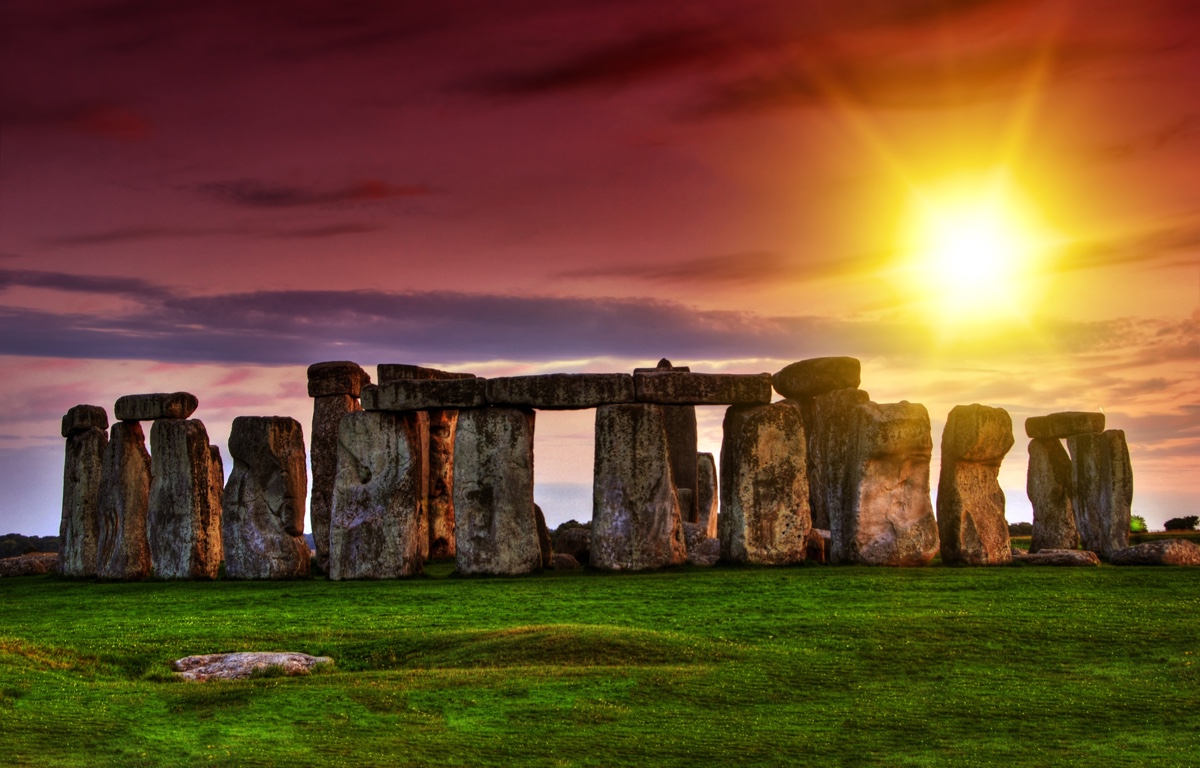New Controversial Idea About Stonehenge Has Archaeologists Shaking Their Heads

The towering rocks at Stonehenge are so heavy that, according to a new controversial idea, a glacier, rather than Neolithic people, may have carried them from western Wales and dropped them off at Salisbury Plain in England, where the ancient monument stands today.
But many archaeologists disagree, saying that this hypothesis lacks evidence and downplays the achievements, skill and imagination that the ancient builders likely displayed.
So, what do the facts show? Live Science took a look, so you can decide for yourself. [5 Strange Theories About Stonehenge]
Quick background
Stonehenge's history extends as far back as 8500 B.C., when Mesolithic people dug pits for totem-pole-like posts at the site. The first stone pillars were erected there in about 2500 B.C. and rearranged by people over the next several thousand years, according to English Heritage, the charity that manages historic sites in England.
The monument has two main stone types that come from different places: The larger sarsen stones in the outer ring — which stand up to 30 feet (9 meters) tall and weigh an average of 25 tons (22.6 metric tons) — likely come from Marlborough Downs, located about 20 miles (32 kilometers) north of Stonehenge.
The bluestones (named for their bluish tinge when wet or broken) are considerably smaller. They weigh up to 4 tons (3.6 metric tons) and are made up of about 30 types of rock that come from several locations in western Wales, a distance of about 140 miles (225 km).
Just how these bluestones got to Stonehenge is up for debate.
Get the Space.com Newsletter
Breaking space news, the latest updates on rocket launches, skywatching events and more!
Glacier hypothesis
In his new, self-published book, "The Stonehenge Bluestones" (Greencroft Books, 2018) — due out June 1 — Brian John argues that glaciers picked up the bluestones in western Wales and dropped them off in Salisbury Plain. John is a geomorphologist, a scientist who studies how landscapes change over time, and works as an independent consultant in the United Kingdom.
This glacier hypothesis isn't new; it was first proposed in 1902 in the journal Archaeologia. But a seminal 1923 paper by British geologist Herbert Henry Thomas — who linked the bluestones to rock outcrops in Pembrokeshire in western Wales — dismissed the glacier idea.
"Since 1923, people have taken that statement [from Thomas] as more or less definitive," John told Live Science. "Archaeologists, in general, have assumed that if the ice couldn't have carried them, therefore they must have been carried by human beings."
But this interpretation is mistaken, John said. "People have loved this story … all of the heroic ancestors slaving away, collecting up these stones from west Wales and then carrying them all the way to Stonehenge," he said. "We all love heroic tales, and I think that's why people have just accepted this, more or less, at face value without any questioning of the evidence on which it's based."
John looks at it this way: Most of the bluestones aren't well-carved pillars but rather "boulders and slabs and rather clumpy bits of stone" that are characteristic of rocks caught up in glaciers. Moreover, about 500,000 years ago, the Irish Sea Glacier covered parts of the United Kingdom. It's not yet clear how far this glacier extended, "but it's a reasonable assumption that since it was such a big glacier, it may well have reached the edge of Salisbury Plain and possibly even to Stonehenge," John said. [Glaciers Disappear in Before & After Photos]
Meanwhile, he said there's no evidence that humans carried, pushed or boated the boulders to Stonehenge (archaeologists disagree). When employing Occam's Razor, the idea that the simplest explanation is often the correct one, it makes sense that a glacier brought over the bluestones, rather than people finding and bringing the megaliths over, John said.
He also noted that Stonehenge looks unfinished, likely because the glacier didn't drop enough bluestones nearby for people to complete it. This fits a pattern seen in other ancient stone monuments in the United Kingdom, in which stones were collected locally, not from far away, he said.
Humans hypothesis
Archaeologists, to put it mildly, disagree.
"[The glacier hypothesis] is looking increasingly untenable," Josh Pollard, a professor of archaeology at the University of Southampton in England, told Live Science. "We just don't find evidence of glacial deposits with big chunks of bluestone anywhere near Stonehenge. And it's inherently unlikely that Neolithic communities would have entirely picked over and removed all deposits of glacial [stones]."
Pollard is part of The Stonehenge Riverside Project, whose members have studied the rock outcrops in Pembrokeshire that match the stones at Stonehenge. Two outcrops, called Craig Rhos-y-felin and Carn Goedog, have evidence of Neolithic activity, including shallow ditches, stone tools and charcoal deposits that date to the Mesolithic, Neolithic and Bronze Age, Pollard said. These artifacts could be evidence left by the people who quarried there for Stonehenge, he said.
In addition, the bluestones don't look like glacial debris, known as moraine, he said. "The bluestones are quite pillar-like blocks. Many now have suffered attrition, particularly through Roman and later removal of the stones and souvenir hunting," Pollard said. "[They weren't] the type of stones you would find in glacial moraine, which would be smaller, rounder boulders."
Glacial rocks are typically scuffed up, he added. While some of the bluestones at Stonehenge — such as the spotted dolerite — are too hard to get scrape marks from a glacier, the rhyolites and sandstones aren't, Pollard said.
"I would think [the rhyolite] would just disintegrate, to be honest, if it was in glacial deposits," he said.
As for John's suggestion that there's "no evidence" that ancient people moved the stone, there's this: "We know where some of those rocks started," Pollard said. "We can see where they've been extracted from the rock outcrops, and we know they end up at Stonehenge. That is, if you like, the evidence of movement." [In Photos: A Walk Through Stonehenge]
What's more, other stone monuments in the Neolithic United Kingdom do include rocks from afar, including Scotland's Ring of Brodgar and Ireland's Newgrange. Even though other monuments include only local stone, that doesn't mean exceptions don't exist, he said.
"It's important to remember that Stonehenge is a very exceptional monument," Pollard said. "It's iconic for a reason: because in the Neolithic world, there's nothing else quite like it."
As for it being unfinished, it's true that Stonehenge was rearranged throughout its history. But prehistoric people routinely remodeled their monuments, he said. Bluestone debris found at Stonehenge also indicates that there were once more pillars there, he added.
In addition, if a glacier had, indeed, dropped bluestones around Stonehenge, it's curious that the prehistoric people who lived there shortly before the time of Stonehenge didn't make monuments out of them, said Barney Harris, a doctoral student of archaeology at University College London.
Foreign, glacial stones "do seem to have been a source of wonderment in prehistory," Harris told Live Science. "In other locations around the United Kingdom, glacial [stones] are quite focused foci of ritual activity. They might be decorated with rock art, or they might have been converted into some kind of stone monument."
Bluestone mystery
So, how were the bluestones moved? In a 2016 experiment, Harris and his colleagues found that just 10 people were needed to haul a sled and giant block over a short trackway at about 1 mph (1.6 km/h), Live Science previously reported.
Such a trackway, filled with a mishmash of timber and branches, could have helped Neolithic people drag the stones to Stonehenge, Harris said. Smaller stones could have been tied with a timber litter, which can help people carry stones around difficult terrain, he said.
It's even possible that these blocks were floated on rafts for part of the way, Harris said.
Although challenging, such a feat might have united people. Moving the bluestones could have helped certain people show off or advance their social standing in the community, he said. "These events were usually associated with feasting and gathering, and could have been useful places to meet potential partners," Harris said.
Therein lies the impasse: John says archaeologists bask in the so-called heroic achievement of ancient people, while archaeologists say John underestimates our prehistoric ancestors.
"[John] doesn't give prehistoric people credit for a capacity to do remarkable things," Pollard said. "He's got an idea that everyone in prehistory was following the easiest route of least effort."
Original article on Live Science.
Join our Space Forums to keep talking space on the latest missions, night sky and more! And if you have a news tip, correction or comment, let us know at: community@space.com.

Laura is an editor at Live Science. She edits Life's Little Mysteries and reports on general science, including archaeology and animals. Her work has appeared in The New York Times, Scholastic, Popular Science and Spectrum, a site on autism research. She has won multiple awards from the Society of Professional Journalists and the Washington Newspaper Publishers Association for her reporting at a weekly newspaper near Seattle. Laura holds a bachelor's degree in English literature and psychology from Washington University in St. Louis and an advanced certificate in science writing from NYU.

